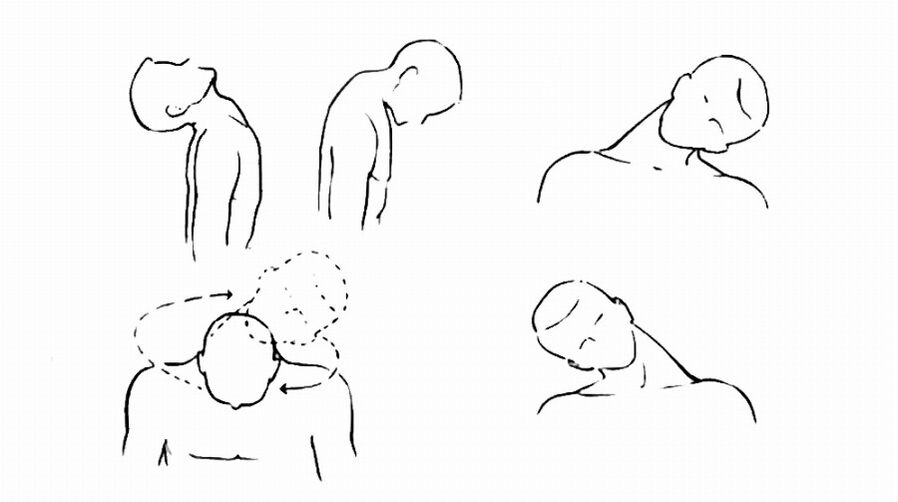In middle-aged women and men, osteochondrosis of the cervical spine (SC) is diagnosed most often because this section is more susceptible to stress. The first signs of the disease are often unexpressed, so it is difficult to identify the problem in the early stages of development. The manifestation of osteochondrosis is associated with the influence on the body of many factors. In order for the treatment regimen for cervical osteochondrosis to be adequate, it is important to investigate the root causes of the onset.

The main causes of the disease
Cervical osteochondrosis is a pathology of a degenerative-dystrophic nature, in which, under the influence of negative factors, the tissues of the intervertebral discs in the neck area begin to collapse. Over time, the disease affects other structures of the spine, which impairs its functioning. The person begins to be disturbed by unpleasant symptoms, the state of health gradually deteriorates.
The main cause of spinal degeneration is a violation of metabolic functions in the body. The vertebrae and intervertebral structures do not receive the necessary nutrients and elements. The bone growth of osteophytes appears on the bone tissue. Ossification is spread out over time. Launched osteochondrosis leads to the fact that the cervical spine, due to the fusion of the vertebrae, comes to a standstill.
The trigger mechanism for the development of such processes are negative factors that constantly affect the human body. The causes of osteochondrosis are as follows:
- congenital pathologies of the structure of the musculoskeletal system,
- hereditary predisposition,
- intense physical activity,
- passive lifestyle,
- violation of posture,
- back injuries
- scoliosis,
- stress, nervous overload,
- complication after serious infectious diseases.
Degree and manifestation of the disease

Signs of osteochondrosis of the cervical spine gradually develop. As the pathology progresses, the symptoms become more pronounced. There are 4 stages of development of chondrosis:
- At 1 degree, there are no obvious symptoms of osteochondrosis. Sometimes a headache can be unsettling, as well as discomfort in the neck. Symptoms quickly disappear after rest, but degenerative processes have already started in the discs, in which the integrity of the nucleus pulposus is disturbed.
- When the pathology has passed to stage 2, the intervertebral cartilage is covered with cracks, through which the nucleus of the disc exits. The intervertebral space decreases, the patient complains of an acute pain syndrome of chronic form.
- In the 3rd stage of development, osteochondrosis of the cervical spine is characterized by vertebral headaches and severe headaches. Due to hypoxia, brain cells suffer, a person may have temporary limb paralysis, hearing and vision problems. Hernias appear on the cervical area, which compresses nerves, muscles, arteries, and veins.
- With the passage of the disease to the last (4 tbsp. ), Symptoms of cervical osteochondrosis in men and women become so pronounced that the patient cannot relax and rest even for a minute. Osteophytes form on the vertebrae, which reduces the mobility of the neck, a person becomes disabled. If complex treatment is not started at this stage, the situation may end in death.
Typical symptoms
Conservatively, 1 to 2 degree osteochondrosis is treated effectively. In advanced cases, it is difficult to completely restore the destroyed intervertebral structures. This means that it is important to diagnose the disease in the initial stages. Therefore, it is necessary to urgently consult a doctor if a person has similar symptoms:
- acute painful discomfort, which is localized in the neck, shoulders, back of the head,
- severe headache and dizziness resulting from compression of the nerves and vessels in the cervical spine by the vertebrae,
- violation of visual and auditory functions,
- muscular weakness
- numbness, goosebumps feeling running on the skin
- failure of the function of the vestibular apparatus.
Cervical osteochondrosis in the C4-C6 vertebrae is characterized by impaired sensitivity of the upper limbs, hands and fingers. If the vertebral artery is compressed, dangerous disorders occurring in the brain are worrying. Due to insufficient blood supply and nutrition of brain cells, hypoxia occurs. If the patient is not treated in time, the patient will have memory problems, the swallowing function will be impaired, and the pinching in the throat where the Adam's apple is located will be disturbed.
Often even a person's voice changes, and with the progression of cervico-thoracic osteochondrosis, heart pathologies occur.
How is the diagnosis made?

If a person suspects that he is developing osteochondrosis of the cervical vertebra, it is necessary to consult a neurologist who will conduct an initial examination and try to find out the main causes of the development of the disease. During palpation, it will be possible to approximately determine the stage of the pathology, its course - with or without displacement. To confirm the diagnosis, the patient will need to undergo a number of such instrumental diagnostic studies:
- X-ray. This will help determine the degree of osteophyte growth, the size of the interarticular gap.
- MRI or CT. Allows to assess the degree of destruction of intervertebral discs, as well as the condition of other soft structures.
- Doppler ultrasound. Helps to identify abnormalities in the functioning of blood vessels, due to which the blood supply to the brain is impaired.
How to deal with the problem?
If the diagnosis is confirmed during the diagnosis, based on the results obtained, the doctor selects the optimal treatment regimen for cervical osteochondrosis. If the disease does not start, you can get rid of it with drugs and the help of auxiliary procedures. At 3-4 stages, the drugs are often powerless, the best solution in this case is surgery.
Effective medicine
Medical treatment for osteochondrosis of the cervical spine during the acute period is primarily aimed at relieving inflammation, swelling, and pain. For these purposes, the following groups of drugs are prescribed:
- Nonsteroidal anti-inflammatory drugs. Eliminates inflammation, reduces swelling, relieves pain. With an exacerbation of the pathology, it is recommended to be used in the form of injections, when the symptoms subside a little, you can drink pills.
- Pain relief.
- Muscle relaxants. Relieve muscle spasms, thus freeing nerves and blood vessels.
- Chondroprotekoty. They restore damaged cartilage structures and prevent their further destruction. For a positive effect, it is recommended to take the drugs of this group for a long time.
- Vasodilators. They help to improve blood circulation, due to which the nutrition of the brain is normalized.
- Vitamins of group B. They normalize the metabolism in the body, stimulate the immune system, due to which soft and bone tissues regenerate faster.
Complex exercise therapy

With the help of therapeutic exercises, it will be possible to quickly restore the affected structures of the cervical spine. You can cure the disease by following the following approaches:
- the head turns in different directions,
- rotational movements,
- shoulder rotation,
- raise and lower your head.
Physiotherapy and massage
Cervical osteochondrosis is successfully treated with the help of physiotherapeutic procedures, which are prescribed by a doctor, taking into account the individual characteristics of the organism. Most often it is recommended to take the following courses:
- magnetotherapy,
- laser heating,
- ultrasound,
- electrophoresis,
- ozokerite applications,
- hydrogen sulfide and radon baths,
- ultraviolet radiation.
With the defeat of osteochondrosis of the cervical spine, it is useful to take a course of therapeutic manual massage. The procedure should be performed by a qualified physician who is familiar with the diagnosis and x-ray images. Thanks to the punctual impacts, caresses, tapping and vibrations, it will be possible to restore normal blood circulation, to establish nutrition of damaged areas.
Treatment with folk remedies

It is possible to treat cervical osteochondrosis by unconventional methods, but first you need to see a doctor. A compress prepared according to this recipe will help relieve pain, inflammation and swelling:
- Wash the cabbage leaf, cut off coarse fibers, knead well.
- Apply a mixture of honey and aloe juice (2: 1) on the leaf, spread evenly over the surface.
- Heat the compress with steam, then apply to the neck, securing it with cling film and a woolen scarf.
- Wear a bandage for 3 to 4 hours.
It is recommended to make a compress daily - in the morning and in the evening.
Prevention and prognosis
With timely and adequate treatment, the disease can be cured and complications avoided. If the problem is not treated and a doctor's advice is ignored, the prognosis for recovery is disappointing. As a prophylaxis for cervical osteochondrosis, it is important to lead an active lifestyle, monitor posture, exercise, eat well, and consult a doctor if you have any suspicious symptoms.



















